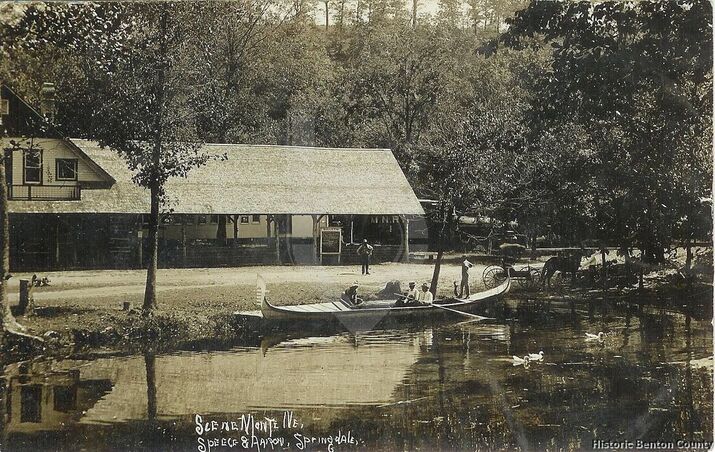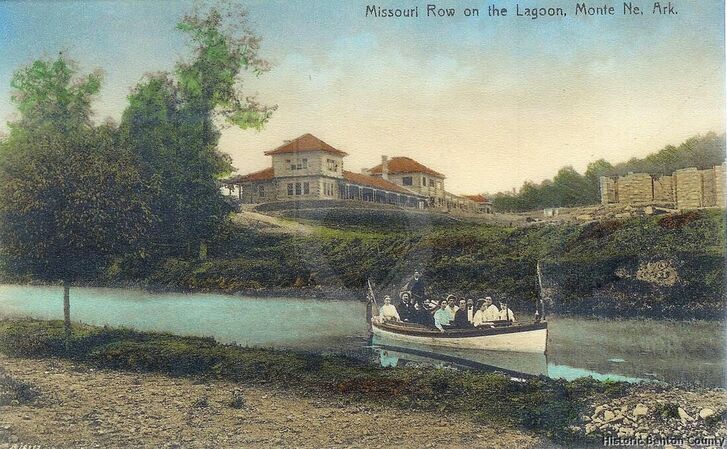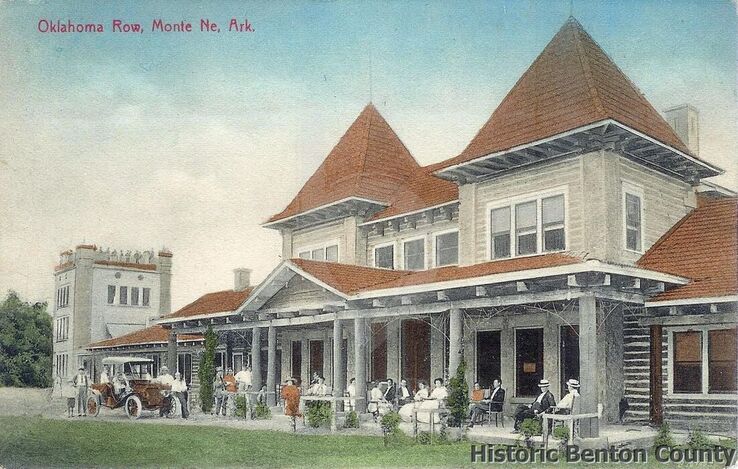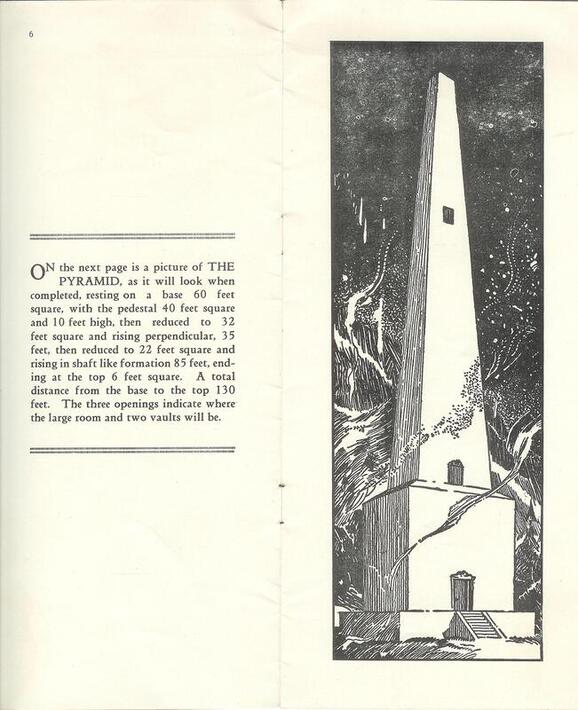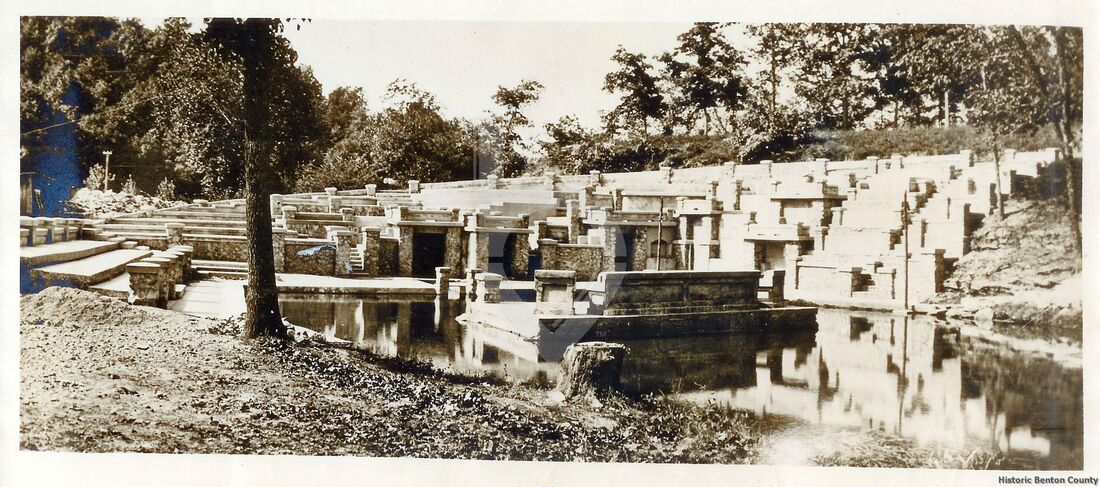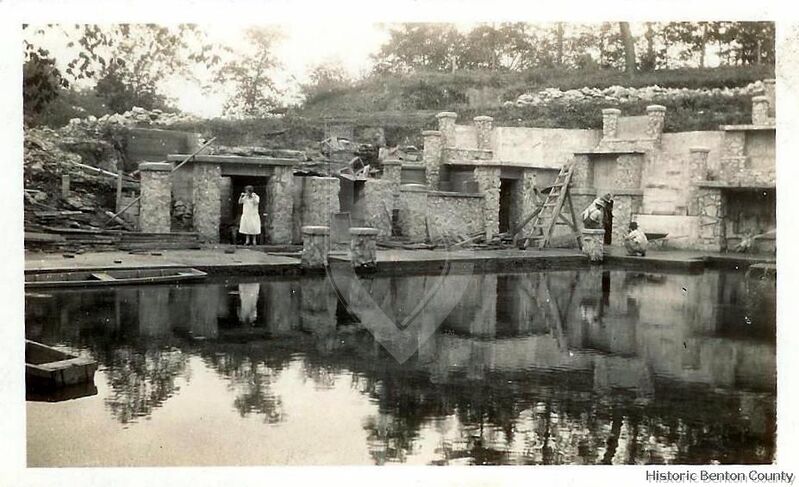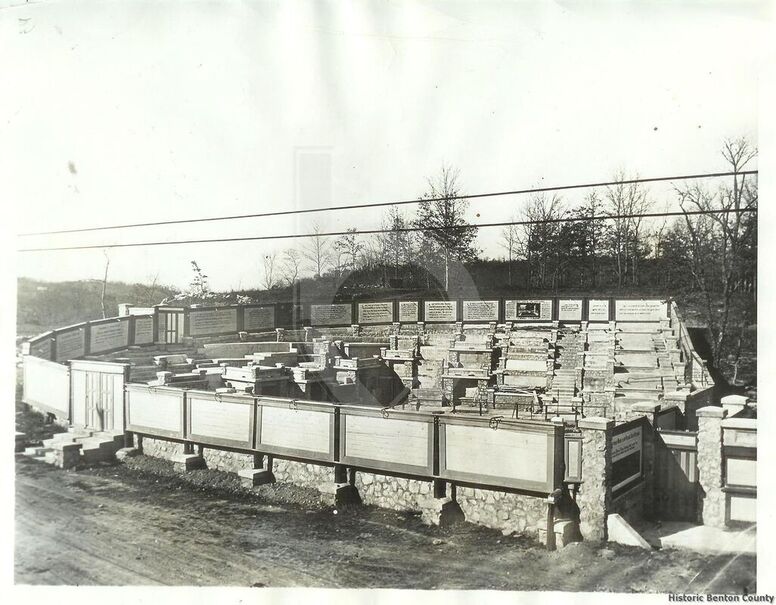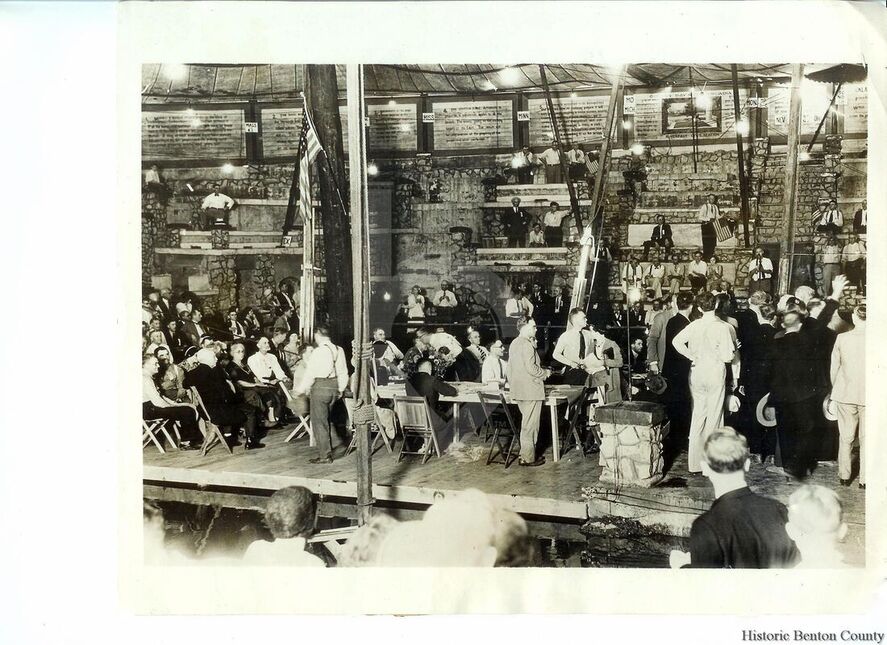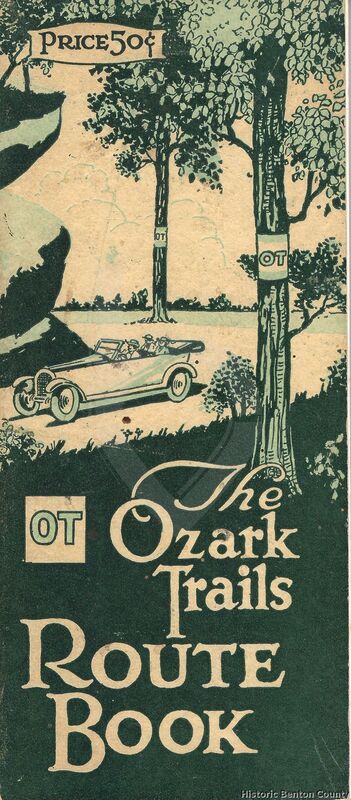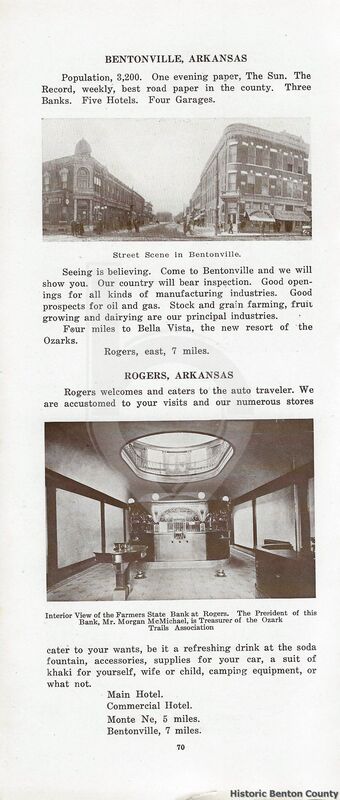"Coin" Harvey Failed to Achieve Fanciful Dream of Monument to Preserve Relics of Civilization
Article from the Diamond Jubilee edition of the Rogers Daily New 8/28/1956 (Now the NWA Democrat Gazette)
Article from the Diamond Jubilee edition of the Rogers Daily New 8/28/1956 (Now the NWA Democrat Gazette)
One of the most fabulous individuals of the Rogers area of a generation ago was the late Col. William Hope "Coin" Harvey, who spent more than a third of a century in the development of a fantastic empire at Monte Ne, only to see it all tumble before his death.
Col. Harvey achieved national prominence in 1896 when, as chairman of the Democratic National Committee, he masterminded the campaign of William Jennings Bryan for President of the United States on the Democratic ticket.
Bryan's free-silver platform, by which he hoped to remonetize silver on a basis of 16 silver dollars to one of gold, came largely from Col. Harvey's theories on currency reform. Harvey's writings on the subject of money were widely accepted, and one of them, "Coin's Financial School," gave him the nickname which remained throughout the rest of his life.
Disappointment over refusal of the American people to accept his currency reform theories through the election of Bryan, Col. Harvey left a lucrative law practice to move to Monte Ne, where he continued to meditate upon the evils of the American monetary system.
Col. Harvey came to Monte Ne, then a village known as Silver Springs, in 1900 and began the development of what was to become the most popular summer resort in the Middle West. Far ahead of his time, Col. Harvey recognized the appeal of the Ozarks to summer vacationers, and he set about to care for them on a grand scale. Highways and automobiles as we know them today were non-existent, and Col. Harvey had to arrange to get his customers to Monte Ne if his resort were to thrive as he had planned.
To meet this obstacle, he built a short-line railroad from Monte Ne to Lowell, where his line connected with the Frisco. At the height of the resort's popularity, special trains were run from St. Louis and other cities to bring vacationers to the Ozarks.
Col. Harvey achieved national prominence in 1896 when, as chairman of the Democratic National Committee, he masterminded the campaign of William Jennings Bryan for President of the United States on the Democratic ticket.
Bryan's free-silver platform, by which he hoped to remonetize silver on a basis of 16 silver dollars to one of gold, came largely from Col. Harvey's theories on currency reform. Harvey's writings on the subject of money were widely accepted, and one of them, "Coin's Financial School," gave him the nickname which remained throughout the rest of his life.
Disappointment over refusal of the American people to accept his currency reform theories through the election of Bryan, Col. Harvey left a lucrative law practice to move to Monte Ne, where he continued to meditate upon the evils of the American monetary system.
Col. Harvey came to Monte Ne, then a village known as Silver Springs, in 1900 and began the development of what was to become the most popular summer resort in the Middle West. Far ahead of his time, Col. Harvey recognized the appeal of the Ozarks to summer vacationers, and he set about to care for them on a grand scale. Highways and automobiles as we know them today were non-existent, and Col. Harvey had to arrange to get his customers to Monte Ne if his resort were to thrive as he had planned.
To meet this obstacle, he built a short-line railroad from Monte Ne to Lowell, where his line connected with the Frisco. At the height of the resort's popularity, special trains were run from St. Louis and other cities to bring vacationers to the Ozarks.
This shows the Monte Ne train depot with the Monte Ne railroad engine in the station.
To accommodate his resort visitors, Col. Harvey erected two massive log hotels, a frame hotel building, and began construction of a third building which he termed a "clubhouse." The two log structures were the first of five of the same type he had planned. The two completed buildings were called "Oklahoma Row," and "Missouri Row," and the three others were to be named for states.
This is a postcard of Missouri Row at Monte Ne. This was the first of two large wooden log hotels built at Monte Ne. The stone structure off to the right was the start of the Clubhouse Hotel which was never completed.
This is a postcard of Missouri Row
The project, however, never got beyond the first two buildings. One of them has long since gone to ruin and the other in now is occupied by the Palace Galleries. [Part of this structure was moved up the road when Beaver Lake was built. You can still see the remains of the building as you head toward Monte Ne.]
Part of the frame hotel building has been torn away, and the remainder is now occupied as a private dwelling. The "clubhouse" never got beyond the foundation stage after a strike of stonemasons halted the work and it was never resumed.
Col. Harvey found time to continue the development of his economic theories, and some of them he put into effect in his numerous business enterprises. He established a bank, and operated a mercantile and timber business. In these enterprises, Col. Harvey sought to operate with his own "money," a form of scrip which was negotiable in trade at his establishment, or redeemable in cash at a vaguely stipulated time.
The scrip issued in payment for purchase of timber, with a promise to redeem it in legal tender currency after the timber products had been sold. There is no record of how long this kind of business was carried on, but apparently it did not last long.
Col. Harvey's eccentricities manifest themselves in many ways.
It has been reported that his Monte Ne resort lost popularity when he decided his guests were making too much noise and he ordered all lights out by 9 p.m. It is said that the place was without customers on the very first night the lights-out order became effective.
After the wane of the resort business, Col. Harvey turned his attention to the development of an integrated highway system, which he called "The Ozark Trail," and the erection of a concrete pyramid as a monument to what he termed "a dying civilization."
Col. Harvey bitterly opposed the payment of interest on borrowed money, either private or public. He termed this traditional practice as "usury" and was sincerely convinced that interest payments would bring about the fall of the modern civilization.
Hoping to warn generations thousand of years hence of the pitfalls of "usury," Col. Harvey set about building his monument to a "dying civilization."
The project appealed to the imagination of people all over the world, and contributions of money poured in from every quarter to help build the monument, which would carry a complete record of the Twentieth Century.
Part of the frame hotel building has been torn away, and the remainder is now occupied as a private dwelling. The "clubhouse" never got beyond the foundation stage after a strike of stonemasons halted the work and it was never resumed.
Col. Harvey found time to continue the development of his economic theories, and some of them he put into effect in his numerous business enterprises. He established a bank, and operated a mercantile and timber business. In these enterprises, Col. Harvey sought to operate with his own "money," a form of scrip which was negotiable in trade at his establishment, or redeemable in cash at a vaguely stipulated time.
The scrip issued in payment for purchase of timber, with a promise to redeem it in legal tender currency after the timber products had been sold. There is no record of how long this kind of business was carried on, but apparently it did not last long.
Col. Harvey's eccentricities manifest themselves in many ways.
It has been reported that his Monte Ne resort lost popularity when he decided his guests were making too much noise and he ordered all lights out by 9 p.m. It is said that the place was without customers on the very first night the lights-out order became effective.
After the wane of the resort business, Col. Harvey turned his attention to the development of an integrated highway system, which he called "The Ozark Trail," and the erection of a concrete pyramid as a monument to what he termed "a dying civilization."
Col. Harvey bitterly opposed the payment of interest on borrowed money, either private or public. He termed this traditional practice as "usury" and was sincerely convinced that interest payments would bring about the fall of the modern civilization.
Hoping to warn generations thousand of years hence of the pitfalls of "usury," Col. Harvey set about building his monument to a "dying civilization."
The project appealed to the imagination of people all over the world, and contributions of money poured in from every quarter to help build the monument, which would carry a complete record of the Twentieth Century.
This is what the Pyramid was supposed to have looked like had it had been completed.
This structure was to be the foyer to the Pyramid. It was actually a retaining wall for the building of the Pyramid, which was to have been constructed at the top of the hill behind this.
Manufacturers and publishers in many parts of the country prepared special items and periodicals, all specially treated to withstand the ravages of time, to be sealed inside the massive concrete spire. All of this to be opened 2,000 years hence by people of that age to provide evidence of the collapse of the earlier civilization.
A large portion money of the money contributed was used in the construction of a massive stone works of weird architectural design, built around the beautiful Big Spring. This he called the "foyer" to the pyramid. The "foyer" was enclosed by a solid board wall, the panels of which bore inscribed quotations from his numerous financial writings. For a fee, a visitor was allowed through the gates to inspect the "foyer " and at the same time absorb some of the Havey financial theories from the wall panels.
A large portion money of the money contributed was used in the construction of a massive stone works of weird architectural design, built around the beautiful Big Spring. This he called the "foyer" to the pyramid. The "foyer" was enclosed by a solid board wall, the panels of which bore inscribed quotations from his numerous financial writings. For a fee, a visitor was allowed through the gates to inspect the "foyer " and at the same time absorb some of the Havey financial theories from the wall panels.
This postcard is of the "foyer" being built. It is said that Mr. Harvey had no plans for how this was to be built but would go out each day and tell workers what he wanted done.
This shows the wooden panels around the outside of the "foyer"
While his pyramid promotion occupied most of his time, Col. Harvey never despaired of seeing his financial theories adopted by the people of the United States. He continued the limited distribution of his earlier tracts and pamphlets, and was the founder of the Liberty Party, whose platform dealt almost entirely with financial reform.
The Liberty Party gained a scattered following in all part of the country. The party held its first, and only, national convention under a large tent stretched over the pyramid foyer at Monte Ne in August, 1931. Col. Harvey was nominated as the party's presidential candidate, although he at first refused to allow his name to be presented. The objectition was withdrawn, however, when the convention threatened to recess for three months without selecting candidates.
The Liberty Party gained a scattered following in all part of the country. The party held its first, and only, national convention under a large tent stretched over the pyramid foyer at Monte Ne in August, 1931. Col. Harvey was nominated as the party's presidential candidate, although he at first refused to allow his name to be presented. The objectition was withdrawn, however, when the convention threatened to recess for three months without selecting candidates.
This is a view of the 1931 Liberty Party Conventing at Monte Ne.
Andrae B. Nordskog, of Los Angeles, Calif., was nominated as the party's vice presidential candidate. The Liberty Party made a token campaign, but failed to win a place on the ballot in most states.
Col. Harvey was one of the first to foresee the need for a system of highways to handle the increasing number of automobiles, and it was largely due to his foresight that the United States adopted a system of, at first naming, and then numbering its highways as an aid to travelers.
Col. Harvey was the guiding light in the organization of the Ozark Trails Association, founded at Monte Ne in 1913 at a meeting of good- roads enthusiasts from four states.
The association adopted the initials "O.T." as the official emblem, and before long the emblem, painted on telephone poles, fences and trees became familiar in Arkansas, Missouri, Kansas and Oklahoma, and as far west as New Mexico and Colorado.
Col. Harvey's map of the Ozark Trails system, published about 1915, probably was the nation's first road map.
Col. Harvey was one of the first to foresee the need for a system of highways to handle the increasing number of automobiles, and it was largely due to his foresight that the United States adopted a system of, at first naming, and then numbering its highways as an aid to travelers.
Col. Harvey was the guiding light in the organization of the Ozark Trails Association, founded at Monte Ne in 1913 at a meeting of good- roads enthusiasts from four states.
The association adopted the initials "O.T." as the official emblem, and before long the emblem, painted on telephone poles, fences and trees became familiar in Arkansas, Missouri, Kansas and Oklahoma, and as far west as New Mexico and Colorado.
Col. Harvey's map of the Ozark Trails system, published about 1915, probably was the nation's first road map.
This is the front page of the Ozark Tail Route Book. The other page is one from inside the route book.
The association's objective was explained in a pamphlet issued in 1915. "The plan of the association," the pamphlet said, "is to promote a system of good roads connecting the four states of Arkansas, Kansas, Missouri and Oklahoma, and to mark them so that travelers will have no difficulty in following the same, never losing their way, and having no uneasiness of mind as to the route, while traveling."
Later, when automobiles became more numerous and the states undertook the building of highways, the Ozark Trails system went into the discard, but Harvey's idea of naming or numbering roads remains in effect until this day.
Finally convinced that his ideas on finance were far ahead of his time, his resort properties long since having passed into other hands, and his monument to a "dying civilization" still nothing more than a nebulous dream, Col. Harvey retired to the comfort of his cottage above Big Spring to while away the remaining years of his life. There, with his eyesight almost entirely gone, he died on February 11, 1936, at the age of 85 years.
The mortal remains of the great dreamer now rest securely encased in a mammoth block of cement in the peaceful valley below Big Spring [the tomb was later moved to higher ground when Beaver Lake was built], along the bank of the lagoon once plied by Venetian gondolas for the transportation and entertainment of visitors to his famous resort. Entombed in the same monolith with Harvey is the remains of a son, Halliday Harvey, who was killed in a railroad accident at Fort Smith in 1903.
While most of his works have disappeared, Col. Harvey's influence still is felt in the Monte Ne community, and will be for generations to come. There are few who doubt that Monte Ne will someday experience a revival and once again become the great resort Col. Harvey dreamed it would be.
Later, when automobiles became more numerous and the states undertook the building of highways, the Ozark Trails system went into the discard, but Harvey's idea of naming or numbering roads remains in effect until this day.
Finally convinced that his ideas on finance were far ahead of his time, his resort properties long since having passed into other hands, and his monument to a "dying civilization" still nothing more than a nebulous dream, Col. Harvey retired to the comfort of his cottage above Big Spring to while away the remaining years of his life. There, with his eyesight almost entirely gone, he died on February 11, 1936, at the age of 85 years.
The mortal remains of the great dreamer now rest securely encased in a mammoth block of cement in the peaceful valley below Big Spring [the tomb was later moved to higher ground when Beaver Lake was built], along the bank of the lagoon once plied by Venetian gondolas for the transportation and entertainment of visitors to his famous resort. Entombed in the same monolith with Harvey is the remains of a son, Halliday Harvey, who was killed in a railroad accident at Fort Smith in 1903.
While most of his works have disappeared, Col. Harvey's influence still is felt in the Monte Ne community, and will be for generations to come. There are few who doubt that Monte Ne will someday experience a revival and once again become the great resort Col. Harvey dreamed it would be.

